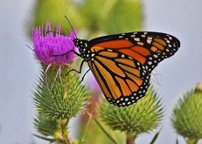Rural Perspectives
Monarch butterflies produce four generations per year
by Diane Constable

The monarch butterfly will travel up to 3,000 miles in early autumn to spend the winter in Southern California and Mexico. Photo credit Diane Constable
The beautiful monarch butterfly (Danaus plexippus) was given its common name by the early European settlers who named it in honor of the Dutch King William II, formally titled the Prince of Orange.
This butterfly has four generations per year and only lays eggs on the milkweed plant species. She will lay up to 500 eggs that will hatch in about four days. Two weeks later, the 3-inch-long caterpillar with white, yellow and black bands forms a cocoon. In 10-14 days, it emerges as an adult butterfly with a wingspan of up to 4.5 inches.
You can tell the gender of this butterfly by looking for a dark spot, which is a scent gland on the mid-lower part of its back wings. This dark spot only appears on the male.
Adults live four to five weeks. They can be found in fields and gardens and feed on nectar. Some of their favorite flowers are sunflowers, thistle, milkweed, coneflowers, goldenrod, zinnia, petunia and salvia.
The monarch is one of few butterflies to migrate seasonally. In the early autumn, the fourth generation of the year travels up to 3,000 miles to overwinter in Southern California and Mexico. With a wing beat of up to 720 times per minute, they will fly about 100 miles per day and use the sun and an internal magnetic compass to stay the course. The cooler winter temperatures at their wintering grounds make them less active and keeps them from maturing fully until the following spring. Unlike the others, this generation will live up to eight months.
In the spring, this fourth generation heads north. They lay the year’s first generation of eggs in the southern USA and their journey ends. Once mature, the first generation of adults continues the trip north, eventually reaching their northern breeding areas.
Fun Fact: Milkweed contains a poisonous sap which makes the monarch caterpillars taste bad to birds. The bright orange of the adult also warns off birds. Butterflies which mimic the bright orange color, but are not poisonous, have the same protection.
 Diane Constable is an avid photographer. She serves on the Unadilla Township Planning Commission and is a member of the township’s Parks and Recreation Committee. Diane also enjoys her dogs and gardening.
Diane Constable is an avid photographer. She serves on the Unadilla Township Planning Commission and is a member of the township’s Parks and Recreation Committee. Diane also enjoys her dogs and gardening.

